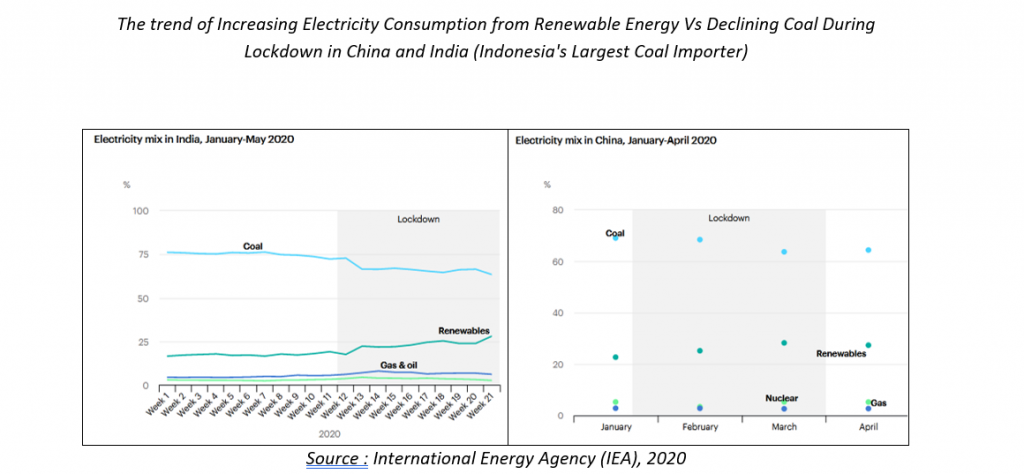Supporting Renewable Should Be Part of Tackling Pandemic
By Sartika Nur Shalati, AEER Coal Researcher
The mineral and coal mining sector which is a mainstay of Indonesian government has decreased because the companies have difficulty to maintain business performance during the period ofCovid-19 pandemic. The Ministry of Energy and Mineral Resources recently released a report on 2019 Non-Tax State Revenue (PNBP) prior to the pandemic that there was a 9.4% decline due to depressed coal prices reaching an average of US$ 77.89 per ton in 2019 was smaller than US$ 85,92 per ton in 2018.[1]
The downward trend in Indonesian benchmark coal prices has continued throughout 2020 and reached the lowest price in July 2020 since the last 4 years of to become US $ 52.16 per ton. This condition is not only worrying for mining companies, but also for the country’s revenue which relies on coal as the largest export commodity reaching around 15 percent export revenue. This decreasing benchmark would be a risk in the realization of PNBP from the target of 44.4 trillion.
Although Indonesian coal production is being sold at the lowest price, the demand in the global market has also declined during pandemic time. The biggest coal importer from Indonesia over the past a decade such as China and India reduced their demand due to unstable national economic conditions. The two countries also diverted electricity consumption to renewable energy during the lockdown period, so that the portion of RE increased significantly from 19% to 28%, inversely proportional to coal from 72.3% to 63.4%. While Gas, Oil and Nuclear remain stable and low.

Source : International Energy Agency (IEA), 2020
The reduction of coal demand is indeed happening in almost all countries. In addition, the increasing global market competition since many coal exporter countries to Europe forced to increase their target markets in Asian. This is happened to Russia which is the biggest coal exporter to Europe due to declining European demand trends. While other coal exporting countries to Europe such as the United States experienced a reduction in exports by 11 million tons and Columbia experienced export constraints due to the access blockade during Covid-19.[2] This proves that besides coal is not environmentally friendly fuel, it is also vulnerable to the crisis situation like Covid-19 compared to renewable energy.
However, some decisions of the Ministry of Energy and Mineral Resources even strengthened the portion of coal in the national energy mix by increasing its production targets each year. In 2020, the government plans to produce coal to 550 million tons, which is higher than in 2019, which amounted to 489.10 million tons. Of this total, around 395 million tons are planned for export. But until July 2020, the realization only reached 146.50 Million Tons (37.09%) which is still far from the target. Meanwhile the allocation for the Domestic Market Obligation (DMO) which meet 92.23 million tons (59.51%) until July 2020 from the planned 155 million tons. To force the coal absorption, the government is trying to optimize domestic marketing and looking for new opportunities in the global market. But this action potentially reduce the focus of the government to reach development of renewable energy.
This is increasingly proven due to the reduction of the Ministry of Energy and Mineral Resources’s budget to develop renewable energy. This was announced at June 25, 2020. The government has categorized Covid-19 as national disaster so funds are allocated to tackle the Covid-19. Fund for renewable energy development and conservation has been cut down IDR 562,8 billion (38 million USD), which was originally planned to reach IDR1.173 trillion (80 million USD).[3]
As coal mining located in forest area, such as PT. Triaryani and PT. Musi Mitra Jaya mining area sending a threat for Hutan Harapan ecosystem restoration area in Jambi, and healthy tropical forest ecosystem is important to avoid spill over pathogen to human habitat, maintain and increasing support for safe renewable energy should be part of effort to tackle covid19 pandemic.
[1] https://www.esdm.go.id/id/booklet/capaian-kinerja-2019-dan-program-2020
[2] https://www.argusmedia.com/en/news/2099068-eu-coal-demand-to-fall-as-imports-reach-30year-low
[3] https://www.esdm.go.id/id/media-center/arsip-berita/-bantu-penanggulangan-covid-19-kementerian-esdm-realokasi-anggaran-rp346-triliun